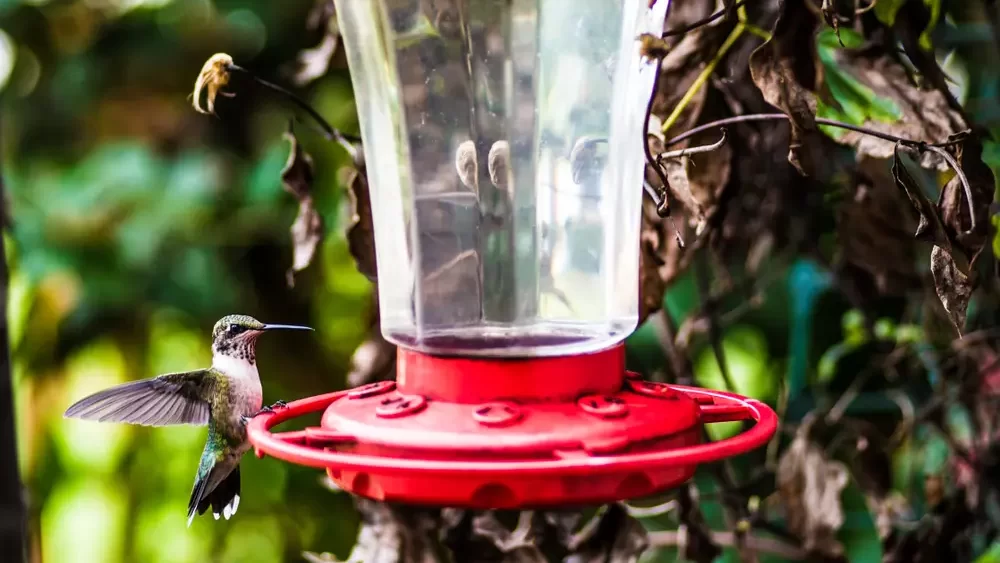Hummingbirds are nature’s jewels, enchanting us with their iridescent colors and incredible flight maneuvers. North Carolina residents are lucky to be able to enjoy the presence of these tiny creatures in their gardens.
But when exactly should you put out your hummingbird feeders in the Tar Heel State to ensure you’re offering a feast to your feathered friends?
Let’s dive into the details and help you set the perfect stage for your hummingbird guests.
Understanding Hummingbirds in North Carolina
In North Carolina, the most common hummingbird species is the Ruby-throated Hummingbird. These captivating creatures are usually present in the state from April to October.
Understanding their habits and preferences can help you create a hospitable environment for them.
Migration Patterns of Hummingbirds
Ruby-throated Hummingbirds spend the winter in Central America and start migrating northwards in early spring.
They typically reach North Carolina between late March and early April. As temperatures cool in the fall, they begin their southward migration, leaving the state by the end of October.

Ideal Time to Put Out Hummingbird Feeders in NC
To attract hummingbirds to your garden, it’s best to put out feeders a couple of weeks before their anticipated arrival.
In North Carolina, setting up your feeders by mid-March will ensure you’re prepared for the early birds. Keep them up until the end of October to accommodate late migrators.
Setting Up Your Hummingbird Feeder
Choose a feeder that is easy to clean and refill, with bright red accents to attract hummingbirds. Place it in a shady location near flowering plants, about 4 to 6 feet above the ground.
This height will deter predators and allow you to enjoy watching the birds as they visit your feeder.
Choosing the Right Nectar
Prepare a homemade nectar solution using a 1:4 ratio of white granulated sugar to water. Boil the water, dissolve the sugar, and let the mixture cool before filling the feeder.
Avoid using honey or artificial sweeteners, as they can harm hummingbirds. Also, there’s no need to add red dye, as the feeder’s red accents are enough to attract them.

Maintaining Your Hummingbird Feeder
Clean your feeder every three to five days in hot weather and every one to two weeks in cooler temperatures.
This prevents mold and fermentation, ensuring a safe and healthy food source for your visiting hummingbirds. Always refill the feeder with fresh nectar after cleaning.
Attracting Hummingbirds with Flowers and Plants
In addition to providing feeders, planting a hummingbird-friendly garden can further entice these delightful visitors.
Hummingbirds are particularly drawn to tubular, brightly colored flowers rich in nectar. Some plants to consider for your North Carolina garden include:
- Trumpet vine
- Salvia
- Bee balm
- Coral honeysuckle
- Fuchsia
- Lupine
- Columbine
- Penstemon
A diverse mix of native plants will not only attract hummingbirds but also support other pollinators and local wildlife.
Benefits of Hosting Hummingbirds
Inviting hummingbirds to your garden offers several benefits. These tiny birds are excellent pollinators, helping your flowers and plants thrive.
Moreover, they consume a considerable amount of insects, acting as a natural pest control for your garden.
Finally, the sheer beauty and entertainment value of watching hummingbirds is a reward in itself.
Frequently Asked Questions
How can I protect hummingbirds from predators?
To safeguard hummingbirds from predators like cats and squirrels, position your feeder at least 4 to 6 feet above the ground and away from trees or structures that can serve as launch points for predators.
Additionally, consider using feeders with built-in ant moats or barriers to keep ants from reaching the nectar.
How many feeders should I put out?
Multiple feeders can help reduce competition between hummingbirds and ensure all visitors have a chance to feed.
Space them out in different locations around your garden to accommodate more birds and avoid overcrowding.
Can I leave my feeder out during the winter?
Although Ruby-throated Hummingbirds typically migrate south in the winter, occasionally a few individuals may linger.
It’s generally safe to leave your feeder out during the winter months in North Carolina, as it may provide a valuable food source for any remaining birds.
Final Thoughts
Welcoming hummingbirds to your North Carolina garden can be an enchanting experience. By setting up your feeders in mid-March and maintaining them until the end of October, you’ll provide a reliable food source for these delightful visitors.
Incorporate native flowers and plants, and you’ll create a hummingbird haven that benefits both the birds and your garden ecosystem.
Thank you so much for giving me accurate information about when to put out hummingbird feeders in NC!! The article was very helpful on how to attract hummingbirds to my yard which will in turn attract other species of birds as well!!